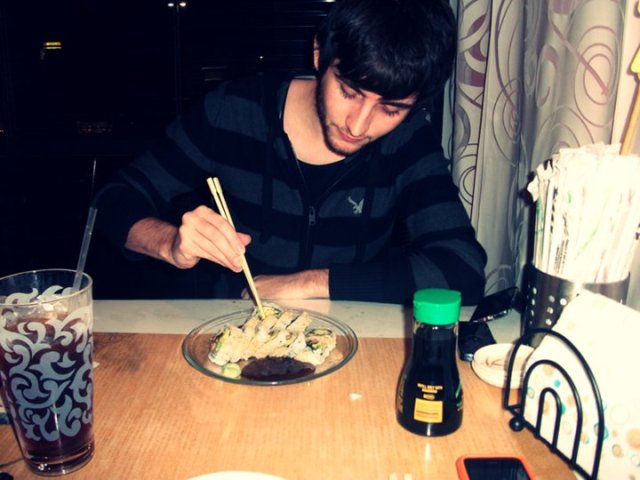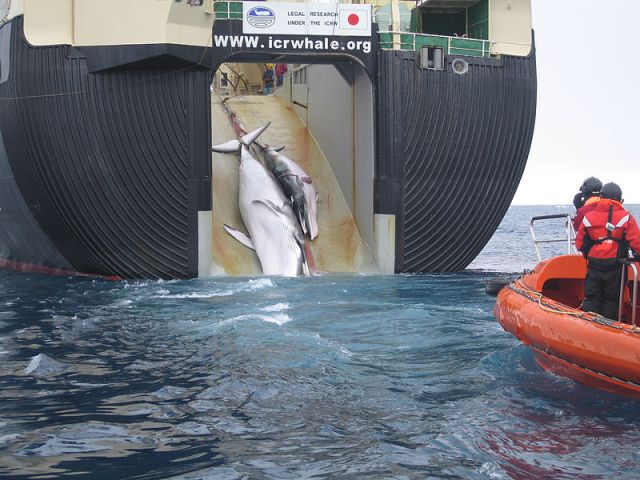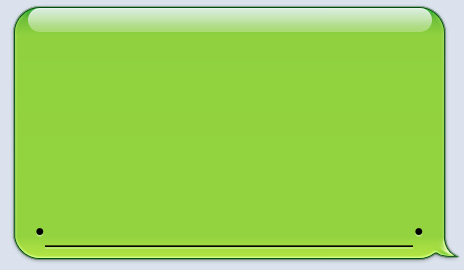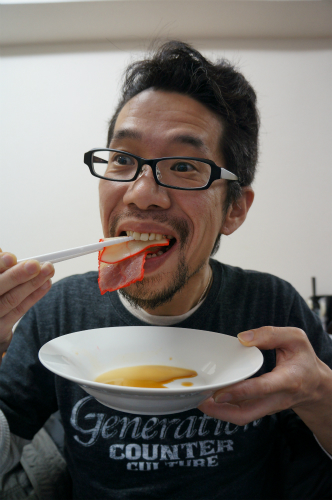whale
These days, Japanese food is pretty widely consumed in the west, even if sometimes the original taste gets slightly lost in translation. In general, though, even non-Japanophiles can be found enjoying a range of Japanese food, whether at home or out for dinner with friends. Sushi is no longer shocking, and “comfort foods” such as okonomiyaki, ramen, and yakiniku can all be enjoyed overseas. But did you know that apparently we’re still making five major mistakes when it comes to Japanese cuisine? Read on to find out if you’re a major offender who doesn’t know their ikura from their elbow!
It’s no secret that you can buy whale meat in Japan. It’s served in schools to young children and even offered up 16 different ways at this shop in Tokyo. In fact, the Japanese have had a history of whaling that dates back to the 12th century. In recent history, however, Japan’s whaling program has been condemned by the international community and its practice of consuming whale meat proven unhealthy. But both whaling and the eating of whale meat, whether you agree with it or not, may be a thing of the past as a result of a recent ruling by the International Court of Justice.
The Ameyoko block of Tokyo is a comprised of a busy market street lined with quaint little shops selling various foods, cosmetics and knick-knacks like clocks. You can expect to find just about anything in Ameyoko, which makes it the perfect location for Geinanhonbo, a whale-meat specialty shop, to open its newest branch.
At Geinanhonbo you can choose from 16 different cuts of whale meat from a giant fridge that takes up most of the shop space. Red meat cuts are relatively cheap, costing 380 yen per 100g (US$1.32/oz), but more expensive parts like the tail or jaw can run up to 2,800 yen per 100g ($9.84/oz). The store offers “almost every edible part of the whale” including the heart, which costs about as much as the red meat.





 Japanese thug wear from Birth Japan perfect for those breaking bad next year
Japanese thug wear from Birth Japan perfect for those breaking bad next year Hello Kitty Choco Egg figures are an adorable trip through three periods of Japanese pop culture【Pics】
Hello Kitty Choco Egg figures are an adorable trip through three periods of Japanese pop culture【Pics】 More Than a Capsule Stay: Why Solo Travelers Choose “global cabin Yokohama Chinatown”
More Than a Capsule Stay: Why Solo Travelers Choose “global cabin Yokohama Chinatown” This is possibly the coziest train in all Japan thanks to onboard hot spring footbaths【Pics】
This is possibly the coziest train in all Japan thanks to onboard hot spring footbaths【Pics】 Japanese artist creates cat banknote alternative: Kittens on 200 yen
Japanese artist creates cat banknote alternative: Kittens on 200 yen Not a fan of dishwashing? Get yourself an electric, plate-scrubbing robot appendage
Not a fan of dishwashing? Get yourself an electric, plate-scrubbing robot appendage 7-Eleven Japan’s ramen-cooking robot whipped us up a bowl of noodles【Taste test】
7-Eleven Japan’s ramen-cooking robot whipped us up a bowl of noodles【Taste test】 Tokyo’s Tsukiji sushi neighborhood asks tour groups to stay away for the rest of the month
Tokyo’s Tsukiji sushi neighborhood asks tour groups to stay away for the rest of the month Naked Japanese bathtub drifting 【Video】
Naked Japanese bathtub drifting 【Video】 Final Fantasy and Shinkansen announce collaboration with in-train audio play, SD art and merch
Final Fantasy and Shinkansen announce collaboration with in-train audio play, SD art and merch Starbucks Japan ready to get Year of the Horse started with adorable drinkware and plushies【Pics】
Starbucks Japan ready to get Year of the Horse started with adorable drinkware and plushies【Pics】 Lacquerware supplier to emperor of Japan and Pokémon team up for new tableware
Lacquerware supplier to emperor of Japan and Pokémon team up for new tableware Japan may add Japanese language proficiency, lifestyle classes to permanent foreign resident requirements
Japan may add Japanese language proficiency, lifestyle classes to permanent foreign resident requirements Cyberpunk anime meets traditional culture in Ghost in the Shell gold leaf Japanese changing screens
Cyberpunk anime meets traditional culture in Ghost in the Shell gold leaf Japanese changing screens Disillusionment at Tsukiji’s tourist-target prices led us to a great ramen restaurant in Tokyo
Disillusionment at Tsukiji’s tourist-target prices led us to a great ramen restaurant in Tokyo 7 great places to see Mt. Fuji from without having to climb it
7 great places to see Mt. Fuji from without having to climb it Starbucks Japan releases new zodiac chilled cup drink for 2026
Starbucks Japan releases new zodiac chilled cup drink for 2026 Japan’s otoshidama tradition of giving kids money at New Year’s gets a social welfare upgrade
Japan’s otoshidama tradition of giving kids money at New Year’s gets a social welfare upgrade 7-Eleven Japan starts new temporary luggage storage service in over 300 branches
7-Eleven Japan starts new temporary luggage storage service in over 300 branches Starbucks teams up with 166-year-old Kyoto doll maker for Year of the Horse decorations【Photos】
Starbucks teams up with 166-year-old Kyoto doll maker for Year of the Horse decorations【Photos】 Tokyo considering law requiring more trash cans following litter increase in heavily touristed area
Tokyo considering law requiring more trash cans following litter increase in heavily touristed area Nintendo’s Kirby now delivering orders at Kura Sushi restaurants, but not in Japan
Nintendo’s Kirby now delivering orders at Kura Sushi restaurants, but not in Japan Tokyo event lets you travel back in time, for free, to celebrate 100 years since Showa era start
Tokyo event lets you travel back in time, for free, to celebrate 100 years since Showa era start Sanrio theme park in Japan announces plans to expand into a Sanrio resort
Sanrio theme park in Japan announces plans to expand into a Sanrio resort Stamina-destroying “Paralysis Noodles” are Tokyo’s newest over-the-top ramen innovation
Stamina-destroying “Paralysis Noodles” are Tokyo’s newest over-the-top ramen innovation Survey asks foreign tourists what bothered them in Japan, more than half gave same answer
Survey asks foreign tourists what bothered them in Japan, more than half gave same answer Japan’s human washing machines will go on sale to general public, demos to be held in Tokyo
Japan’s human washing machines will go on sale to general public, demos to be held in Tokyo Japan’s deadliest food claims more victims, but why do people keep eating it for New Year’s?
Japan’s deadliest food claims more victims, but why do people keep eating it for New Year’s? We deeply regret going into this tunnel on our walk in the mountains of Japan
We deeply regret going into this tunnel on our walk in the mountains of Japan Studio Ghibli releases Kodama forest spirits from Princess Mononoke to light up your home
Studio Ghibli releases Kodama forest spirits from Princess Mononoke to light up your home Major Japanese hotel chain says reservations via overseas booking sites may not be valid
Major Japanese hotel chain says reservations via overseas booking sites may not be valid Put sesame oil in your coffee? Japanese maker says it’s the best way to start your day【Taste test】
Put sesame oil in your coffee? Japanese maker says it’s the best way to start your day【Taste test】 No more using real katana for tourism activities, Japan’s National Police Agency says
No more using real katana for tourism activities, Japan’s National Police Agency says Starbucks Japan reveals new sakura drinkware collection, inspired by evening cherry blossoms
Starbucks Japan reveals new sakura drinkware collection, inspired by evening cherry blossoms Updated cherry blossom forecast shows extra-long sakura season for Japan this year
Updated cherry blossom forecast shows extra-long sakura season for Japan this year Not a fan of dishwashing? Get yourself an electric, plate-scrubbing robot appendage
Not a fan of dishwashing? Get yourself an electric, plate-scrubbing robot appendage 7-Eleven Japan’s ramen-cooking robot whipped us up a bowl of noodles【Taste test】
7-Eleven Japan’s ramen-cooking robot whipped us up a bowl of noodles【Taste test】 Tokyo’s Tsukiji sushi neighborhood asks tour groups to stay away for the rest of the month
Tokyo’s Tsukiji sushi neighborhood asks tour groups to stay away for the rest of the month Naked Japanese bathtub drifting 【Video】
Naked Japanese bathtub drifting 【Video】 Final Fantasy and Shinkansen announce collaboration with in-train audio play, SD art and merch
Final Fantasy and Shinkansen announce collaboration with in-train audio play, SD art and merch Do 100-yen hair removal pads do the trick, or leave our reporters the hairy messes they are?
Do 100-yen hair removal pads do the trick, or leave our reporters the hairy messes they are? Super-tiny manga that you can actually read are our new capsule toy obsession【Photos】
Super-tiny manga that you can actually read are our new capsule toy obsession【Photos】 Woman in Japan accidentally pees herself during live broadcast
Woman in Japan accidentally pees herself during live broadcast Starbucks Japan ready to get Year of the Horse started with adorable drinkware and plushies【Pics】
Starbucks Japan ready to get Year of the Horse started with adorable drinkware and plushies【Pics】 Beautiful sightseeing boat is a floating tea ceremony venue in east Japan’s best hot spring town
Beautiful sightseeing boat is a floating tea ceremony venue in east Japan’s best hot spring town Does Starbucks Japan’s new holiday Frappuccino really taste like a cup of fallen snow?
Does Starbucks Japan’s new holiday Frappuccino really taste like a cup of fallen snow?